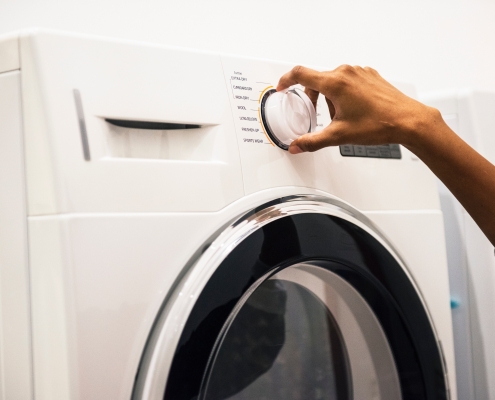![[Image via SpareParts3D]](https://fabbaloo.com/wp-content/uploads/2020/05/Typical-appliance-495x400_img_5eb0a12e35e84.jpg)
Digital inventory and on-demand manufacturing are changing the shape of the supply chain.
Appliance manufacture is especially well-suited to digital inventory solutions, as small knobs and components are susceptible to break in everyday use. Whirlpool is now working with Singapore-based SpareParts3D to develop a 3D printing project for spare parts production.
Over the last year, the two companies have been collaborating to examine viable solutions where 3D printing could prove a good fit for different parts, looking into different additive manufacturing technologies and materials.
The pilot project begun last November focused on 150 parts of various parts, with technical suitability validated fairly quickly. Upon that validation in January, SpareParts3D began a catalog analysis, reviewing more than 11,000 unique parts to see which made sense to bring into their operations to take on obsolescence and shortages. The hefty review process was automated thanks to the company’s DigiPART analysis tool, which follows a four-step process, as SpareParts3D describes:
-
Plug your ERP to your digital catalogue
-
Estimate the technical viability & valuate your Business Cases
-
Centralize all your information in a single place & distribute your production
-
Order your part & follow-up the production
DigiPART will be adding more features soon, such as digital inventory repository and a quotation and ordering system, both of which are currently undergoing beta testing; release is anticipated by the end of 2018 for all SpareParts3D customers.
Of the 11,000+ Whirlpool SKUs reviewed, 7% proved a profitable fit for 3D printing. While about 770 parts may not seem too significant out of that broad a catalog, that’s 770 parts that can be supplied to address the direct needs of a company. Many use cases highlighting 3D printing in production tend to focus on just one or a few solutions; 770 is certainly nothing to sneeze at. Validating hundreds of parts for end use showcases the growth of 3D printing in industry, especially with such a high-profile partner.
“We are proud to count Whirlpool as one of our most valuable partners. Committing in 3D printing is a proof of a creative mindset and leadership for such a well-known company. We are glad to inspire them trust and innovation,” said Paul Guillaumot, CEO of SpareParts3D.
SpareParts3D sees great value in the use of 3D printing for spare parts in the home appliance industry and is using three technologies — MJF, FDM, and SLA — and five materials — ABS, ABS V0, PA12, Rubber-like resin, and PP-like resins — to meet production needs. For Whirlpool, part manufacture will begin with HP’s MJF technology and PA12 material to 3D print a push button.
Customer deliveries have already begun. Next up in this partnership will be a further push toward digitization to more parts, as Whirlpool will continue to work more closely with SpareParts3D to scale up production.
“Spare Parts 3D gave me a pragmatic view on how to use 3D printing in our business,” said Franco Secchi, VP of Consumer Services and Quality for Whirlpool EMEA. “I know we won’t make large production batches with this technology, but there is an excellent value to solve obsolescence and shortage issues which generally fold into low volumes demands. This way 3D printing can have a direct significative impact on our customer care.”
As 3D printing continues to industrialize, companies like SpareParts3D will have an increasingly important role as they validate such steps into adoption for digital inventory strategies. Whirlpool, a global giant in home appliances with $21 billion in sales last year, is opening the door to additional applications in appliances. SpareParts3D is also working in the maritime sector as 3D printing broadens as a spare parts solution.
SpareParts3D’s Guillaumot shares a bit more in this interview (in French, with English captioning):
Via SpareParts3D











